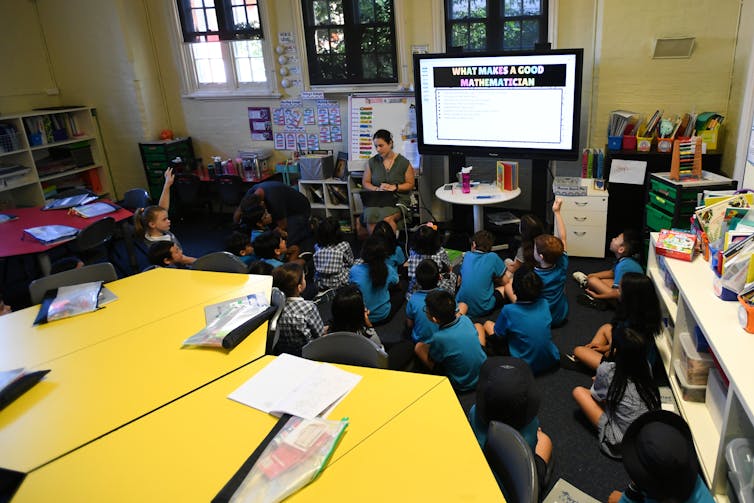
14 Apr How parents can help kids through rough school transitions, smoothly
Year 1 and Year 8 can be surprisingly tough transitions (if your child is struggling, they are not alone), write Nina Van Dyke and Cynthia Leung.
When we talk about “school transitions”, we generally refer to three specific points: starting primary school, starting secondary school, and moving from secondary school to further education or work.
However, school transitions occur every year, and the lack of a smooth transition, particularly if it occurs outside the expected “big years”, sometimes takes both students and their parents by surprise.
The transitions from the first year of school to Year 1 and from Year 7 to Year 8 may be particularly fraught.
Year 1: When school ‘gets real.’
In many Australian states, the first year of school (called kindergarten, prep, transition, reception, or pre-primary, depending on your state) is regarded as a transition year from preschool or kinder to primary school.
For example, in Queensland and Victoria, play-based learning is an important feature. This means there is an emphasis on activities, including manipulative tasks such as jigsaw puzzles, games with rules, sharing and cooperation, and physical activities.

Erik Anderson/AAP
But Year 1 is regarded as a year when school “gets real” – regardless of what state you’re in.
Year 1 has an increased emphasis on academic learning as well as higher expectations around independence and self-regulation. For example, students are expected to cope independently with less adult supervision when going to the toilet and eating lunch, as well as a structured classroom routine. They are also expected to follow school rules, focus and listen in class, complete work to a schedule, and arrive to class on time.
Even for children who seem ready, the jump from the first year of school to Year 1 is a big one.
The ‘Year 8 dip.’
The “Year 8 dip” refers to a drop in motivation and performance that often occurs between the first and second years of secondary school.
In Australia, there is also evidence of a “Year 9 dip”, in which “girls often withdraw or get anxious and boys muck up”.
For example, a 2015 New South Wales study found drops in student engagement during the middle years of high school, with big drops from Year 7 to Year 8 and further drops from Year 8 to Year 9.
A 2014 Gallup poll found 75% of Year 5 students surveyed reported being engaged in school, but only 58% were engaged in Year 8.
Why the Year 8 dip?
Year 8 and Year 9 are often seen as the least important years of secondary school. Year 7 is new, and Years 10 and up are focused on exams and what students will do after they finish school. Year 8, in contrast, has no apparent purpose.
One study found students perceived they had lower levels of teacher support in Year 8 (and even lower in Year 9). Teachers confirmed this perception, agreeing they provided less support to students in Years 8 and 9.
But there is also an element of school becoming more challenging and more work. For example, Year 7 maths is largely a repetition of primary school to catch everyone up and consolidate knowledge. This may lead some students to believe they don’t need to put in as much effort. When they get to Year 8, they are in for a rude shock.
Finally, Year 8 students are no longer the youngest in the school and are conscious of “growing up”. At 13 and 14, peer groups become more important, perhaps shifting the importance of school downwards. And hormones are at their peak, affecting students’ mood and impulse control.
What can parents do to help?
You can do many things to help a child if they are finding the transition to Year 1 or Year 8 bumpier than expected.
Moving into Year 1
Speak positively with your child about the changes they might be experiencing in Year 1, while acknowledging and discussing any concerns they may have. For example, you might say something like:
It seems that you are a bit nervous about Year 1 because there are many new things to learn, and some are a bit difficult. I also had the same feeling when I started a new job where I had to learn to do many new things.
Another example could be:
It seems that you find reading a bit difficult. You are not as good at reading yet as you want to be. But if we read more together, this will help.
Strengthen your child’s independence and planning skills as they move into Year 1. For example, have them pack their own school bag. Discuss setting up a daily routine, such as when to get up, play and snack times, and when to go to bed.
Read regularly with your child to strengthen their language skills, and to prepare them for the increased focus on academic learning in Year 1.
If you have concerns about your child’s progress or how they are settling in, talk to their teacher.

Ketut Subiyanto/Pexels
Going from Year 7 to Year 8
Be enthusiastic about Year 8 (and Year 9) when you talk with your child. Combat the narrative that these years “don’t really matter”. Even though peer opinion is increasingly important, we know parents’ opinions still matter to young people.
Be prepared for a possible drop in enthusiasm or work habits as your child moves into and through Year 8. Spot and address any concerning behaviours early; for example, wagging school or withdrawing from friends. Seek academic or mental health support if needed.
Recognise the increasing maturity of your Year 8 student – provide them with opportunities to have a greater voice in decisions about school or other issues. For example, let them lead a discussion around what electives they take in Year 9 or rules around electronic device use or bedtimes.![]()
Nina Van Dyke, Principal Research Fellow at the Mitchell Institute, Victoria University and Cynthia Leung, Adjunct Professor, Victoria University
This article is republished from The Conversation under a Creative Commons license. Read the original article.

